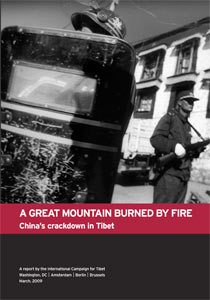March 10, 2009, marks the 50th anniversary of the National Uprising and the first anniversary of an unprecedented wave of overwhelmingly peaceful protests that swept across the Tibetan plateau, to be met by a brutal crackdown. In the weeks before the anniversary and Tibetan New Year (Losar, February 25), the Chinese government stepped up levels of intimidation and adopted an increasingly harsh and systematic approach to silencing Tibetans and suppressing dissent, with the authorities calling upon officials, security forces and the general public to ‘crush’ any signs of support for the Dalai Lama.
State repression and the hardening of the Chinese government’s position on the Dalai Lama have created deepening tension in Tibet, the opposite of the ‘genuine stability’ that President Hu Jintao claims to be seeking. This is the only known period when protests have continued despite the severity of Beijing’s response. A key element of dissent has been the ‘no Losar’ position adopted by many Tibetans, who believe they should mourn the passing of Tibetans killed during the protests despite the Chinese authorities’ endeavors to persuade Tibetans to celebrate in order to give the impression of normalcy.
Over the past year, the Chinese government has engaged in a comprehensive cover-up of the torture, disappearances and killings that have taken place across Tibet combined with a virulent propaganda offensive against the exiled Tibetan leader, Nobel Peace Laureate the Dalai Lama. On the international stage, Beijing has subverted and politicized international forums where its human rights record has been challenged and refused to answer legitimate questions from governments about the use of lethal force against unarmed protestors, or the welfare of individual detainees. The Chinese authorities have sought to represent the unprecedented unrest across the Tibetan plateau over the past year as one ‘violent riot,’ referring solely to the events of March 14 in Lhasa. The reality is that more than 130 overwhelmingly peaceful protests have occurred across Tibetan areas of the PRC since March 10, 2008, and incidents of dissent are continuing in some areas – for instance in Lithang (Chinese: Litang, in eastern Tibet), where Tibetan monks, laypeople and nomads took to the streets on February 16 to make a bold statement in support of the Dalai Lama and to call for the release of a solitary monk protestor detained the day before.
As the 50th anniversary approaches, Tibetans continue to ‘disappear,’ often being taken from their homes in the middle of the night to face extreme brutality in ‘black jails.’ According to figures given in official statistics, 1200 Tibetans remain unaccounted for since the protests began. The spike in numbers of political prisoners since March 10, 2008, is likely to be the largest increase that has ever occurred in Tibetan areas of the PRC under China’s current Constitution and Criminal Law. A list of more than 600 names and details of prisoners who have been detained since March 2008 are provided with this report; the actual number of Tibetans still in detention is likely to be far higher. New campaigns directed against Tibetan culture and religion in the last few months mean that virtually any expression of Tibetan identity not directly sanctioned by the state can be branded as ‘reactionary’ or ‘splittist’ and penalized with a long prison sentence, or worse. Pop stars, artists and writers have been detained under a new drive against “cultural products” with suspect ideological content – such as songs referring to the Dalai Lama – and in music bars Tibetan performers are no longer allowed to address the audience as ‘Tibetan brothers and sisters’ because it is considered ‘subversive’ to the ‘unity of the nationalities’.
Despite the risks, insights from inside Tibet on experiences of imprisonment, interrogation and loss, as well as perspectives on a way forward translated in this report indicate an unquenchable spirit and expression of a deeply-felt Tibetan identity. This includes the first translations into English from the only known book to be published in the PRC about the uprising over the past year. This collection of writing, the ‘Eastern Snow Mountain’, by Tibetans still in Tibet was banned almost as soon as it appeared. One of the authors writes: “In a year that turned out to be like a raging storm… how could we remain… in fear. [This work is] a sketch of history written in the blood of a generation.”


